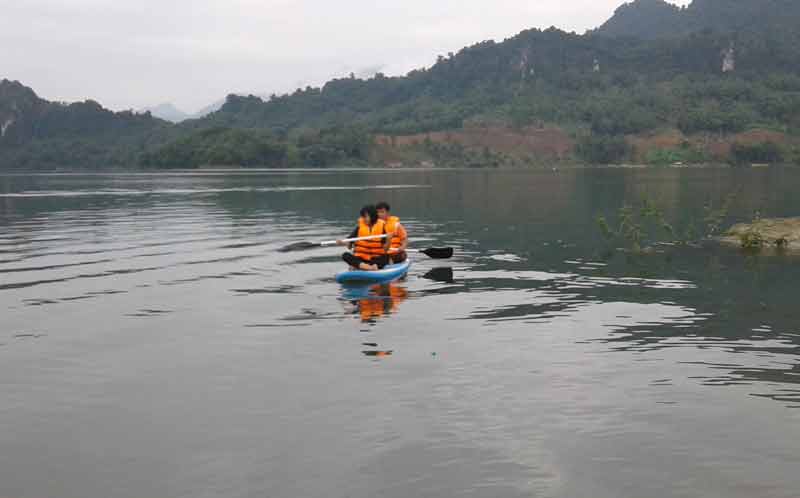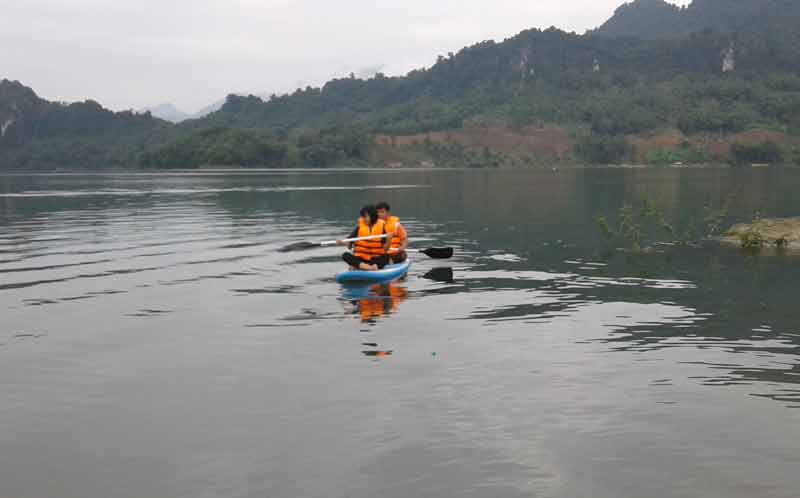
(HBO) - In early 2019, Tan Lac district received over 458.6 million VND (19,757 USD) from the non-governmental organisation Action on Poverty (AOP) to develop community-based tourism. So far, the project has been carried out in two communes - Phu Cuong and Nam Son (now Van Son commune), which helped create livelihoods and improve local incomes.
 Tourists
experience raft rowing at Ngoi village, Ngoi Hoa commune (now Suoi Hoa
commune), Tan Lac district.
Tourists
experience raft rowing at Ngoi village, Ngoi Hoa commune (now Suoi Hoa
commune), Tan Lac district.
The project provided local households with loans to renovate
their houses and necessary skills to engage in community tourism. It also
helped with the building of convenience stores in the locality. In late July
2019, the community-based tourism site in Chien hamlet, Nam Son commune, was officially
put into operation. Since then, it has attracted thousands of visitors.
Tan Lac district has so far lured 10 investment
projects in tourism. Five have been approved by the provincial People’s
Committee, while the remainders are being appraised.
Approved investment projects include the Hoa
Binh Lake resort and eco-tourism project worth over 800 billion VND (34.4
million USD) of Lac Hong Investment joint Stock Company; the eco-tourism area
and May valley nature reserve project worth over 130 billion VND of Hoa Binh
Clean Agriculture joint Stock Company; the Thung Khe spiritual and ecological
tourism project worth nearly 300 billion VND of Cat Tuong Thien joint Stock
Company; the Ngoi Hoa ecotourism project worth 474 billion VND of Hoang Son
Investment Power Construction Trade joint Stock Company; and the V’Star-Ngoi
Hoa ecotourism project worth 125 billion VND of V’Star joint Stock Company.
Projects pending approval include the Ngoi Hoa ecotourism
project invested by Hoshi Vietnam group, the forest protection in combination
with tourism project by Gia Ngan joint Stock Company, the Muong ethnic cultural
and tourism project in Ngoi village by Hoa Binh Tourism-Investment Company, the
Ho Guon-Song Da ecotourism project by Ho Guom group, and the Dao Hoa valley
ecotourism project by the Hoa Binh Clean Agriculture joint Stock Company.
The district has been actively calling for
investment in tourism. Besides implementing well the State management in
tourism and improving human resources, the locality has intensified
communications to raise public awareness of tourism development.
Tourism in Tan Lac is expected to become a
spearhead economic sector in the coming time. In 2019, the district welcomed 130,658
visitors, up 24,192 compared to 2018. Of the figure, more than 4,500 were
foreigners. The tourism sector grossed over 45 billion VND (1.9 million USD) in
revenue, surpassing the yearly target by 0.6 percent./.
Located just a 20-minute drive from Hoa Binh City, Ora Hill Farmstay & Glamping Hoa Binh is a captivating new destination nestled in Mo hamlet, Bình Thanh commune, Cao Phong district. Combining farming with leisure, this tranquil retreat is perfect for those seeking balance, joy, and an immersive experience in the expansive beauty of nature.
Muong Bi - Tan Lac is renowned as one of the four famous Muong regions in Hoa Binh province. Blessed by nature with a favourable climate and stunning landscapes, Tan Lac holds great advantages for tourism development. The local tourism industry has made remarkable strides in recent times thanks to the attention and support from the local authorities and sectors.
With its strategic location, well-developed transport network, and diverse soil and climatic conditions, Hoa Binh is emerging as a must-visit destination in Vietnam's northwestern tourism corridor. The province boasts numerous attractions, including the Kim Boi hot springs (Kim Boi district), the Dau Rong cave complex (Cao Phong), the Mai Chau valley (Mai Chau), and the iconic Hoa Binh hydropower plant.
The northern mountainous province of Hoa Binh has been listed among the 71 most beautiful places to visit worldwide by the prestigious US travel magazine Condé Nast Traveller.
Hoa Binh province’s rich natural and cultural resources position it as a prime location for developing community-based tourism (CBT). In recent years, support from central and provincial policies, as well as assistance from non-governmental organisations, have encouraged local ethnic minority and mountainous communities to actively engage in the sector.



 Tourists
experience raft rowing at Ngoi village, Ngoi Hoa commune (now Suoi Hoa
commune), Tan Lac district.
Tourists
experience raft rowing at Ngoi village, Ngoi Hoa commune (now Suoi Hoa
commune), Tan Lac district.